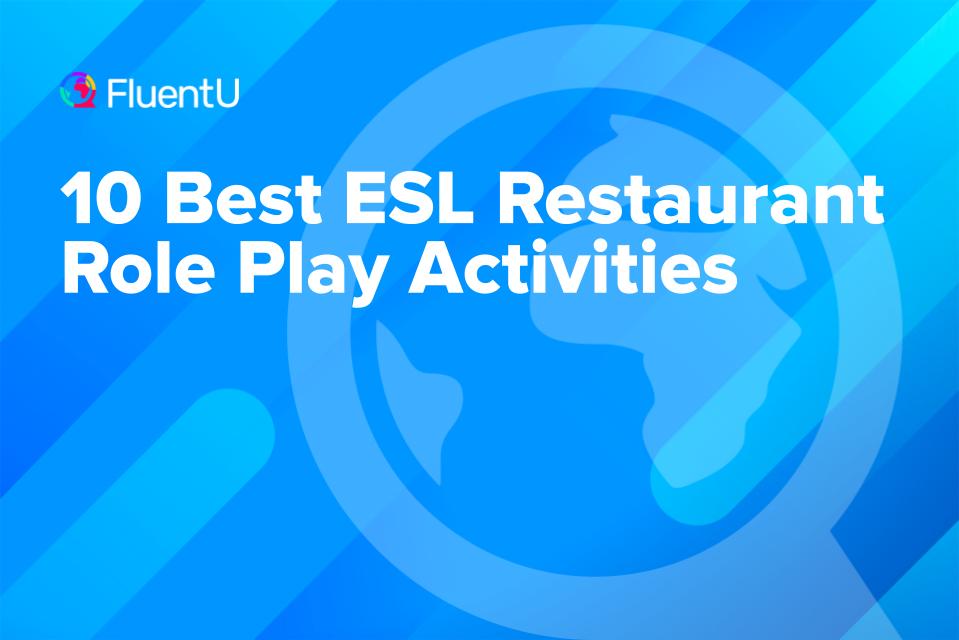10 Best ESL Restaurant Role Play Activities

When students are first learning a new language, they spend quite a bit of time learning grammar, vocabulary and structure, but, let’s face it: it can be kind of frustrating when they still can’t get by in a local restaurant.
This is where ESL restaurant role play activities come in handy—they’re really fun and very practical for learning restaurant and dining vocabulary.
Have a look at nine great restaurant role play activities, plus one longer multi-day restaurant role play activity, when you want to devote an entire week to the restaurant fun.
Download: This blog post is available as a convenient and portable PDF that you can take anywhere. Click here to get a copy. (Download)
Fun ESL Restaurant Role Play Activities
1. Ordering Adventure
Assign your students roles as customers and waitstaff and seat them at desks in an arrangement that feels like a restaurant.
Consider providing menus for each group. Alternatively, you could ask students to create menus for this activity, which will help get them writing about restaurant and food terminology.
Then have them practice their ordering meals, asking for recommendations and handling special requests.
2. Cultural Cuisine Exchange
Each student represents a different country’s cuisine for this activity. You can either assign students countries or regions, or you can ask them to choose their own or a cuisine that they like or are interested in.
Then have them role-play as chefs, sharing their cultural dishes’ details, ingredients and preparation methods. This activity is great because it fosters cross-cultural awareness while they practice using food-related vocabulary.
3. Menu Makeover Challenge
Put students in pairs and have them find a real restaurant menu online. Almost all restaurants have one on their website these days.
Then ask them to redesign the menu for their chosen restaurant. They can either do this on laptops or on paper, if computers aren’t available.
The students will then role-play as chefs and marketers, explaining their menu choices and promoting their dishes to the rest of the class (or to other groups).
4. Mystery Diner Investigation
Assign your students roles as mystery diners and restaurant staff in a restaurant role-play situation.
As the skit moves on, the diners should provide feedback to staff, which can be either positive or negative or both.
Then the staff analyzes the feedback and tells the diners how they’re going to improve their restaurant based on the feedback.
This activity is great for enhancing listening skills, and developing customer service skills, with the slightly formal language this involves.
5. Reservation Role-play
For this helpful role play, you have to first assign students roles as customers and restaurant staff.
Once you do this, have the students put on blindfolds (if you don’t have blindfolds, just covering their eyes will work). This is done so the student has to focus on telephone listening and speaking skills.
Then have the “customer” make and confirm a reservation. The “restaurant staff person” can provide different responses, like offering an alternative time, asking for special requests or politely refusing the reservation because there’s not enough space in the restaurant for that night.
6. Chef’s Special Presentation
Students role-play as chefs, introducing their “special of the day” to customers. This role-play involves explaining the dish’s ingredients, preparation process and the story behind it, enhancing descriptive language and presentation skills.
Then encourage the “diners” to ask a question each about the dish. For example, they could mention a food allergy or about the specific ingredients.
7. Bill Splitting Dilemma
In groups of 3-4, students simulate a situation where friends need to split the bill after they eat. They role-play as customers and waitstaff, navigating discussions on splitting costs, practicing polite negotiation and handling calculations.
To make this one more realistic, make or print out some sample restaurant bills. If you have time, also give them a corresponding menu, so they can check to make sure they were charged correctly for each item.
To discuss this more afterwards, consider giving students this easy-to-read article on bill-splitting on dates and then discussing its main points.
8. Kitchen Chaos Challenge
Assign students roles as cooks, servers and diners and a host in a bustling restaurant. They enact scenarios with order mix-ups, special dietary requests and kitchen mishaps, encouraging quick thinking, problem-solving and teamwork.
This is basically an acting improvisation session, so you might want to explain the basics of improv to students beforehand. For example, never say “no” in an improv session, use your imagination and invent a personal character (a grumpy waiter, a sick customer or an impatient host are good starts).
Before you start this activity, I recommend explaining some of the main things that can go wrong in a kitchen.
Here’s a funny video of restaurant fails to get the ball rolling:
9. Restaurant Review Roundtable
For this run activity, assign your students roles as food critics, restaurant owners and customers. Then put them in groups, with at least one person from each category.
Then have them engage in discussions about recently visited restaurants, offering critiques, compliments and suggestions for improvement.
They can use actual restaurants they’ve been to recently as the basis for discussion, or they can invent a fantasy restaurant experience that they’ve conjured up with their imaginations.
Here’s an informative video that goes through the steps of writing a restaurant review:
The Big Multi-Day ESL Restaurant Role Play
The role play activities discussed already have all been successful for me in my ESL classroom. But sometimes, I want to make the ESL restaurant role play to last for a bit longer, so students can really get the hang of these concepts. That’s when I bring out the big one—the multi-day restaurant role play activity.
Day 1: Vocabulary Discussion and Assignment of Roles
Teacher Prep
On the first day of your restaurant role play, you have to arm your students with all of the tools they’ll need to be successful.
First and foremost, that means giving them the adequate vocabulary that they’ll need:
- Basic food vocabulary
- Specific restaurant phrases and vocabulary
Based on these resources, come up with a manageable list of terms for your class. Consider your students’ skill levels and, of course, terms they may already be familiar with when coming up with your list.
As for how to teach these terms, you have a few options. We have a ton of sample vocabulary lessons that you can get your inspiration from, but in this context, here’s just one example of how you can go about it.
Icebreaker
Start with an icebreaker. Find a picture of a person in a restaurant and ask your students to describe what they see. This will give you an opportunity to assess their acquired vocabulary and also to introduce the game that will be taking place over the course of the next few lessons.
The Lesson
Next, introduce the vocabulary using techniques like eliciting words by showing your students pictures or brainstorming as a class.
Once your students have their complete vocabulary list, it’s time for a game to get them thinking and speaking. Here are some of our favorite vocabulary games that you can choose from to help them practice their new vocabulary. You can also encourage students to create flashcards so that they can practice their vocabulary over the next few days.
Assigning Roles
Near the end of class, when you have about 10-15 minutes left, it’s time to dole out the roles. Depending on the size of your class, you’ll want to split students into pairs, groups of two or groups of three. Each group will have one waiter and one, two or three diners. Be sure to take into account your shyer students when creating the groups.
Once you have assembled the groups, give your students a homework assignment: Have them begin to write about the last dining experience they can remember, or give them a creative writing assignment about either the best or worst restaurant experience they can imagine. The goal of the assignment is to get them thinking, so there’s no need to be too structured in the form of the assignment.
Day 2: Interactive Creation of Décor
Teacher Prep
The next day is going to be a fun day, provided you’ve done all your prep in advance. On the second day of the week, you and your students will create the décor and menus you’ll be needing on day 3.
The key to making sure that this day is a success is ensuring that you have all the materials your students will need. Some examples include:
- Drop-cloths or sheets to serve as tablecloths
- Paper or cards for creating menus
- An array of pencils, pens, markers and even magazines for collages
- Authentic materials like trays, glasses, plates and cutlery
The Lesson
The possibilities are endless, provided you give your students the right tools. Let their imaginations be their guides, but encourage each group to create all of the props they’ll need for their role play game, including tables, table settings, plates of food (that’s where collages can come in handy!) and even costumes. Encourage them to name their restaurants and come up with characters to play.
While students are preparing their props, your role is to encourage them to speak English. Wander the room, keeping an ear out for the correct use of vocabulary and structure, particularly when students are using vocabulary they’ve learned. If they need extra words, be sure to give them to them.
Revision and Conclusion of Class
After your students have cleaned up their projects and put aside their materials for the next day, reserve about 5-10 class minutes to ask each student what the name of their restaurant is and who their characters are. The next day is game day, so encourage students to prepare a simple costume and to revise their vocabulary as homework.
Day 3: Establishment of Situation and Role Play
Teacher Prep
Prepare several pieces of paper with strange restaurant situations written on them. Prepare at least two per group. Here are a few ideas:
- The electricity has gone out
- The chef has run out of salt
- There’s a spider in the soup
These will come in handy!
The Lesson
Time to play!
Each group can begin by setting up a corner of the room for their role play. Depending on how many groups you have, one or several groups won’t start out by playing, but rather by observing.
While the groups that are playing are preparing, gather the groups that are starting as observers in a corner of the room. Explain to them that you’ve prepared a series of situations for the other groups to deal with, and either give each student a piece of paper or allow them to choose one.
Start the game as quickly as possible, so that everyone has time to play. Allow groups to play for 3-5 minutes before encouraging an observer to throw a wrench in the works with a strange situation. The groups have to react to the situation in their role play—without dropping character!
As the teacher, be sure that you’re monitoring students for correct vocabulary usage. There’s no need to over-correct during role play, but be sure to take notes on frequent or glaring mistakes you can address later.
Give each group about 15-20 minutes of play.
Conclusion
Ask students for their impression of the game. Keep the conclusion light and fun—tomorrow is when the hard work returns!
Day 4: Follow-up
Teacher Prep
Review your notes and decide which mistakes you’re going to discuss as a class. This can be anything from incorrect structures to lacking vocabulary. Be sure to discuss mistakes that are within the realm of your students’ knowledge.
If your students have never learned the conditional, this might not be the time to discuss it, but if they were continuously using the wrong expression or misusing a tense that they do know, you can bring it up.
Icebreaker
Ask students to tell you their favorite part of the game from the day before.
The Lesson
Review the mistakes that you prepared in advance. Allow students to attempt to correct the mistakes themselves before you give them the entire right answer.
Once you have reviewed the mistakes, it’s time for a writing exercise. Depending on your students’ level, you can ask them to write about any number of things:f
- A summary of the role play
- An essay about their favorite and least favorite parts of the role play
- A reaction to one of the other groups’ role play
- An analysis of their reaction to their strange situation
Allow students the rest of the class period to finish and decide, at your discretion, whether students can finish the assignment at home or not.
For more food-themed ESL activities, check out this post:
20 ESL Food Activities | FluentU English Educator Blog
Looking to make English more appetizing for your ESL students? Look no further than these 20 activities involving everyone’s favorite subject: food! Read this post to get…
You’re going to need to do quite a bit of planning in advance to make sure this activity is a success, but if you get all your ducks in a row, an ESL restaurant role play activity can easily be the source of learning and amusement over the course of four class sessions. Or you can just choose one of the shorter role plays.
It’s always valuable to provide some visual context prior to role play exercise. Be sure to explore the FluentU library to find some appropriate videos to model these behaviors and conversations. You can get started today by requesting a free trial of the program.
Download: This blog post is available as a convenient and portable PDF that you can take anywhere. Click here to get a copy. (Download)







